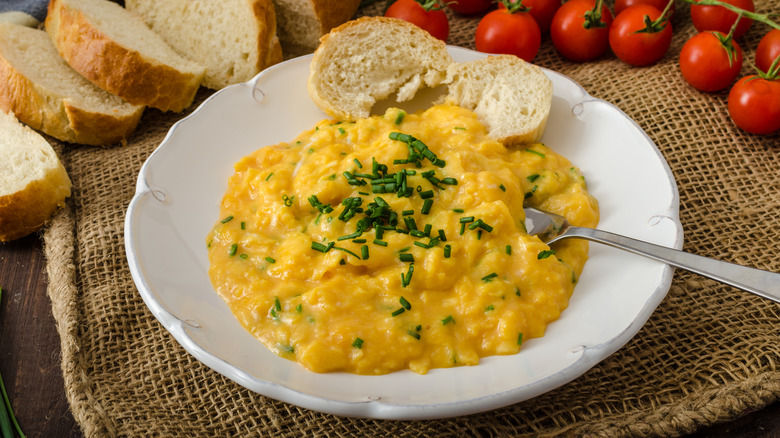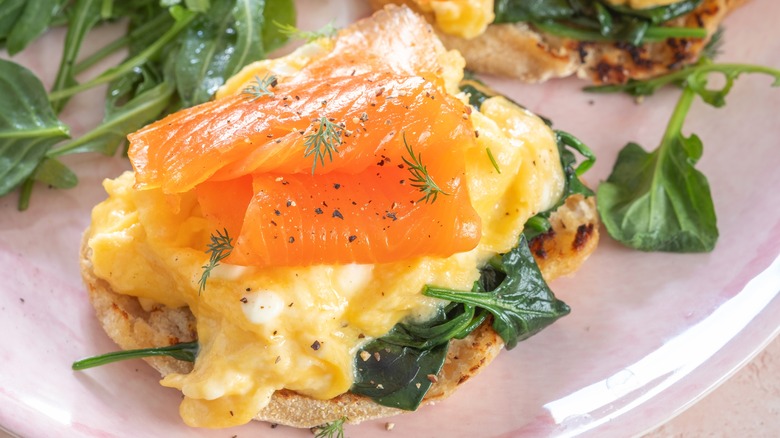Ina Garten's French Method For Velvety Scrambled Eggs
We may receive a commission on purchases made from links.
Creamy and comforting, perfectly cooked scrambled eggs make for an indulgent meal any time of the day. And there are a number of ways to prepare them, depending on your preference — from different cooking methods to incorporating additional ingredients. For some, the key to soft scrambled eggs is a little bit of acid, such as lemon juice or vinegar. Other modifications add butter or cream for more texture.
In her "Cook Like A Pro" cookbook, Ina Garten explains that she loves to use the French technique for scrambling eggs, a method which produces very soft and fluffy results, or what the Barefoot Contessa sweetly describes as "scrambled egg clouds." With their fine, delicate curds and soft silky texture, French scrambled eggs, known as les œufs brouillés, are almost custard-like in texture. It makes the dish very different than the larger, firmer curds that result when eggs are scrambled American-style.
One of the key factors that creates this difference is the temperature and time for which the eggs are cooked. Because, while the French method might be simple, it's not exactly fast to make. In fact, one of the key ingredients is patience. But if you devote the extra time, the reward is pure unadulterated luxury.
The French method uses low heat for extra creamy eggs
Recipes for scrambled eggs vary across the world, with the French style all about soft, buttery decadence. The secret is the low-and-slow cooking process. Proteins in eggs can sometimes become tough when cooked over a high heat, but the French method switches that up by cooking over low heat over a longer time, all but ensuring the eggs stay deliciously soft.
For a classic technique, the French culinary bible "Larousse Gastronomique" advises that the whisked eggs should be added to a heavy pan with melted butter, and stirred constantly with a wooden spoon over low heat. Once removed from the heat, cold butter or heavy cream are mixed in to enrich the dish. Ina Garten's take on the French method involves whisking eggs with half-and-half, and leaving the mixture in a buttered skillet over a low heat for several minutes without stirring. She then folds the eggs with a spatula until they reach a loose, custardy texture.
Some chefs believe that, for true French-style scrambled eggs, they should not be whisked before being added to the pan, while others prefer to even blend the eggs before they hit the pan. But while the processes are slightly different, the low heat and longer cooking time are what produces the signature soft texture. Just remember to take the eggs off the stovetop before they're ready, as the residual heat in the pan will continue to cook them.
How to make French-style eggs even more luxurious
While French-style scrambled eggs are delicious served on their own, the slow-cooked dish can be elevated even further if you want to make an extra-special weekend brunch. Ina Garten uses white truffle butter to lend extra richness and flavor to her scrambled eggs, incorporating the aromatic addition once the pan has been taken off the heat, but before the eggs are fully cooked.
Fresh herbs, such as dill, tarragon, parsley, or chives, also work well with French-style scrambled eggs, while cookbook "Larousse Gastronomique" recommends artichoke hearts or cep mushrooms sauteed in butter as an accompaniment; spoon them on top of the eggs before serving. Bacon, prosciutto, or smoked salmon also make an ideal partner for the creamy dish, creating a flavorful, protein-packed brunch, while adding lightly sauteed spinach makes for a tasty, balanced, and colorful plate.
But, whether you choose to keep things simple or go all-out with the garnishes, the key to great French-style scrambled eggs is patience. Soft, silky, and sophisticated, these eggs are worthy of your time, and the perfect indulgent dish.



